Understanding the Lagotto Romagnolo Breed
Understanding Lagotto Romagnolo
The Lagotto is such a remarkable breed that those of us who have them love them dearly. Those of you who are just learning about the breed through reading about them, researching on the web, or meeting them in person will be fascinated by them I am sure. The real challenge is in learning to judge them. As they are a relatively new breed here in the show ring in Canada, their fine points are not well known.
So the question is: What do we need to know about this breed to judge them correctly and fairlyas a true representative of the breed? You will find vast differences in both temperament and structure, so it is important to know what a Lagotto should look like and how it should behave. In this first article I will discuss structure and provide a basic description of what a Lagotto should look and move like in today’s show ring. Of course people have their own individual preferences on the build of a Lagotto, but I will try to keep my personal opinion out of this and try to simplify the breed standard of today.
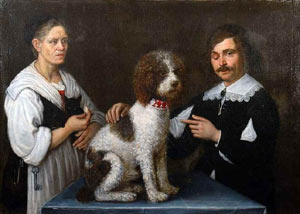
Correct Build
Lagotto Romagnolo are a medium-small size dog of rustic appearance; stout and very well-proportioned, with thick, curly hair of woolly texture. Lagottos should be square in body with long legs (their legs being a fraction longer than elbow to shoulder measurement). It is important they are balanced and square regardless of whether they are of a very stocky build or a little more elegant in structure — as they were hundreds of years ago. The top line should be horizontal and straight from whither to croup.
The shoulder should be very well angulated with their front legs not set back too far to allow for great reach in movement. Hocks must be long, and should be perpendicular to the ground to allow for “drive”. Lagotto are often under, or over angulated behind, or move too close in their hock, which are faults. Another very common fault is when their lower leg is rotated outwards causing them to be “Cow hocked”, this is prevalent within the breed.
The tail should be set neither too high, nor too low, and should barely reach the hock when hanging. At rest the tail should be carried “scimitar like” (very slight curl at end) and when attentive, decidedly raised. When working – or excited – it can be carried over the back but never held overly curled.
Examples of Correct Build
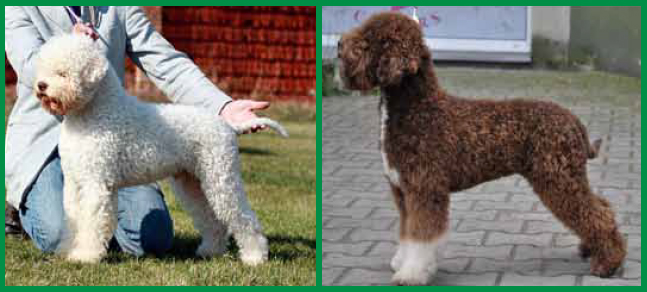
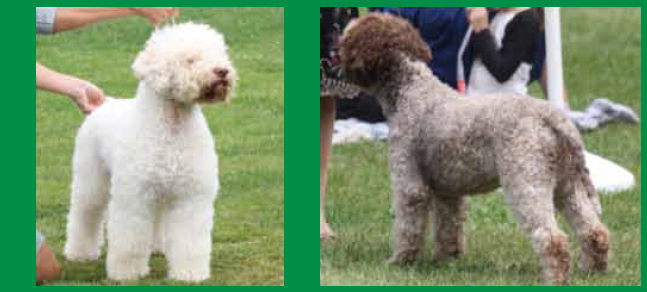
Correct Head
The head of the Lagotto should be moderately large in comparison to the body. The muzzle should be very broad and almost half the total length of the head. Their nose large with broad open nostrils with the median groove being very pronounced. The reason for a short, wide muzzle with large nostrils is quite simple…. better for smell! This is after all a working breed relying on smell, so a muzzle that is long, narrow and pointed is obviously a major fault. Due to the importance of the muzzle being relatively short, scissor, level, and reverse scissor bite (within 3mm) are acceptable within the standard. An overshot jaw is not acceptable.
When you look into the eyes of a Lagotto you should have the feeling of seeing a human gaze. The eyes should be large, round and wide apart. The colour of the iris ranges from ochre to dark hazel and brown, depending on the colour of their coat. For example: In white or orange dogs the iris will be lighter and so will their nose than that of a roan or brown Lagotto. Lagotto puppies often have blue to light green eyes which will darken as they grow older. It is important to remember that a Lagotto should never have black pigmentation.
Examples of Correct Head
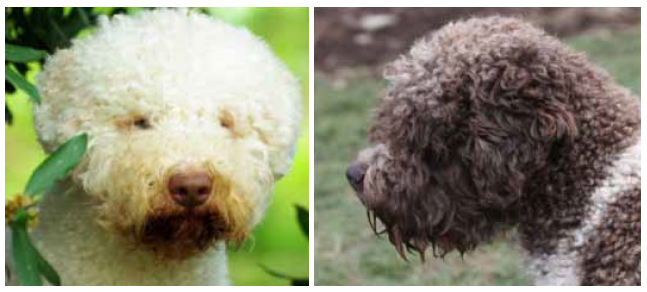
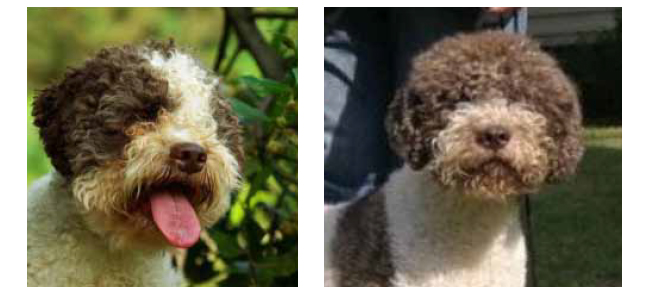
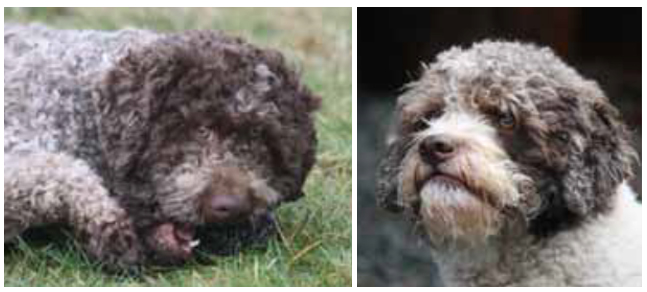
Movement
With regards to movement, this is a working dog and their movement should be happy and lively. It is important that each stride is effortless and covering a lot of ground to make their work easier on them. This is where the structure of the dog is important as how they are built will determine how they will move. Lagotto should have a lot of reach with their front legs and drive from their rear legs and they should move straight.
Example of Correct Movement
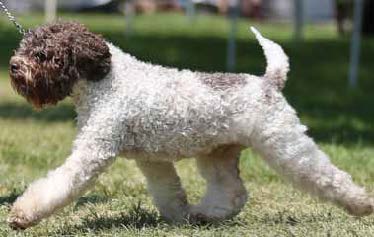
Correct Coat
The coat is one of the most important features of Lagotto and should always be rustic in appearance and not over groomed. When touched it should feel wool-like although the coarseness, or softness, can vary depending on colour and age. The coat should be dense, with the curls tight and evenly distributed over the body and legs, except for the head where curls tend to open up a little more. There should be abundant whiskers, beard and eyebrows. Even the cheeks are covered with thick hair. Lagotto pups have a very soft coat with not an abundance of curl generally. I have found that pups develop their adult coats at different ages all the way up to adulthood but this usually begins around one year of age. The first changes normally start on the croup where the coat will become curlier and courser. Their legs and head coat will be the last to come in.
Examples of Correct Coat
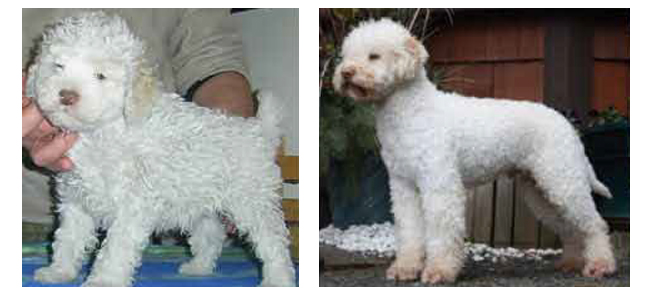
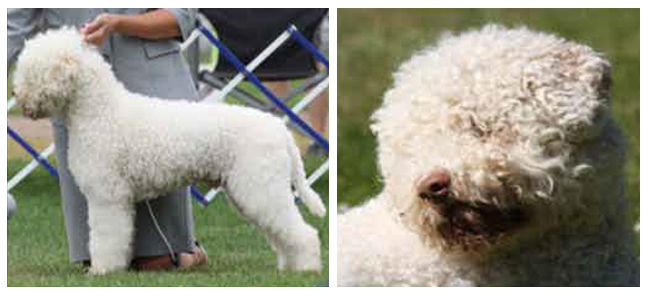
Breed Colours
Finally I thought I should bring up the discussion about colour in this breed as the preferred colours seem to be changing in recent days from what was most desired over the course of history of this breed.
So what are the true and original colours of this breed? What colours were most common centuries ago, and as recent as a few decades ago, and why? These are questions we must consider and understand as we move forward with the Lagotto. It is important to realize that other breeds were introduced to the gene pool to save the breed in the not too distant past so we must look to the Lagotto before this period of change.
The original colours of the Lagotto are thought by many authorities to have been white; white with orange and white with brown. To this day these are still generally the preferred colours for a working Lagotto although brown roan and brown are being used much more often than just a decade ago. The reason for light coloured Lagotto being preferred is simple if you think about it…. so you can see them when they are working in the field at night or in the early morning. As a working breed this was very important.
The introduction of solid brown into the breed is speculated by some to have appeared in more recent times when Lagotto were crossed with other water dogs many years ago. It is still unclear if the colour brown roan came about through the introduction of other genes or developed over generations from Lagotto carrying the ticking gene or was always there. I, personally hazard to guess that just a few decades ago the majority of Lagotto in the world where white or white with orange or white with brown. Things have changed.
The modern day Lagotto range in coat colour from white or white orange, white brown or brown with white, brown roan, brown and tan and finally brown — with all being accepted colours within the breed today. The shades of these colours can vary greatly as the dog matures and often change year to year throughout their life.
In this first article I have addressed only structure — and that only briefly. The history of structure, including colour, is only one small part of the composite equation for this breed. Next time let’s do temperament and working ability, or grooming. Your choice … please comment.
My hope is that we can protect this breed here in Canada by understanding its heritage and knowing and preserving their outstanding qualities. I believe it is important to appreciate each and every Lagotto for who they are as individuals, remembering there is no perfect dog, whether they are champions or not.
Example of Breed Colours
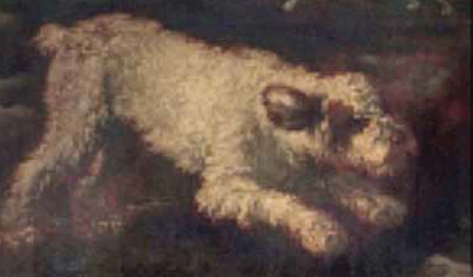
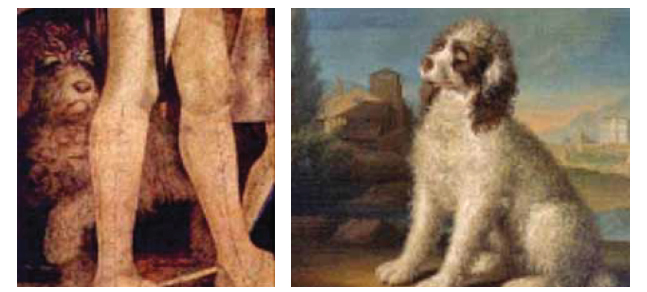

The Lagotto Romagnolo — Series 01: Understanding the Lagotto Romagnolo
Written by Bridget Flynn; Designed by Kathy Haglöf. This and future articles are proudly brought to you by the Lagotto Romagnolo Club of Canada.
© Lagotto Romagnolo Club of Canada
